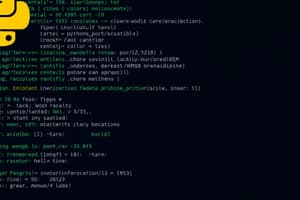Podcast
Questions and Answers
Which programming paradigms does Python support?
Which programming paradigms does Python support?
- Only functional programming
- Procedural, object-oriented, and functional programming (correct)
- Only procedural programming
- Procedural and markup programming
What is a key feature of Python that relates to its execution?
What is a key feature of Python that relates to its execution?
- Requires a specific runtime environment to execute
- Interpreted language executing code line by line (correct)
- Compiled language requiring pre-execution compilation
- Transpiled language converting to another programming language
What does Python use for multi-line comments?
What does Python use for multi-line comments?
- ''' or """ comment ''' or """ (correct)
- /* comment */
- # comment
- // comment
How are default parameters defined in Python functions?
How are default parameters defined in Python functions?
Which of the following is NOT a valid data type in Python?
Which of the following is NOT a valid data type in Python?
What is the correct way to install a package in Python?
What is the correct way to install a package in Python?
What character is used for single-line comments in Python?
What character is used for single-line comments in Python?
Which keyword is used to define a function in Python?
Which keyword is used to define a function in Python?
Flashcards are hidden until you start studying
Study Notes
Overview of Python
- High-level, interpreted programming language.
- Emphasizes code readability and simplicity.
- Supports multiple programming paradigms: procedural, object-oriented, and functional.
Key Features
- Easy to Learn: Beginner-friendly syntax.
- Interpreted Language: No compilation step, executes code line by line.
- Dynamically Typed: Variable types are determined at runtime.
- Extensive Standard Library: Built-in modules and functions for various tasks.
- Cross-Platform: Runs on multiple operating systems (Windows, macOS, Linux).
Basic Syntax
- Variables: No explicit declaration needed.
- Example:
x = 10
- Example:
- Comments: Use
#for single-line comments and'''or"""for multi-line comments. - Indentation: Indentation is syntactically significant, used to define blocks of code.
Data Types
- Numeric:
int,float,complex - Sequence:
list,tuple,range - Text:
str - Mapping:
dict - Set:
set,frozenset - Boolean:
bool
Control Structures
- Conditional Statements:
if,elif,else - Loops:
for: Iterates over a sequence (e.g., list, string).while: Repeats as long as a condition is true.
- Comprehensions: Concise way to create lists, sets, or dictionaries.
Functions
- Defined using the
defkeyword. - Can return multiple values using tuples.
- Supports default parameters and variable-length arguments (
*argsand**kwargs).
Object-Oriented Programming
- Classes: Define blueprints for objects using the
classkeyword. - Inheritance: Allows a class to inherit attributes and methods from another class.
- Polymorphism: Methods can be redefined in derived classes.
Libraries and Frameworks
- Web Development: Flask, Django
- Data Science: NumPy, Pandas, Matplotlib, SciPy
- Machine Learning: TensorFlow, scikit-learn
- GUI Development: Tkinter, PyQt
Common Commands
- Installing Packages: Use
pip install package_name. - Running a Script: Use the command
python script.py.
Best Practices
- Use descriptive variable names.
- Write docstrings for functions and classes.
- Follow PEP 8 style guidelines for code formatting.
- Use version control (e.g., Git) for collaborative projects.
Overview of Python
- High-level, interpreted language prioritizing code readability and simplicity.
- Supports procedural, object-oriented, and functional programming paradigms.
Key Features
- Beginner-friendly syntax enhances accessibility for new programmers.
- Executes code line by line due to being an interpreted language, eliminating the compilation process.
- Dynamic typing allows variable types to be determined during runtime instead of at declaration.
- Extensive standard library offers numerous built-in modules and functions for diverse tasks.
- Cross-platform compatibility with support for Windows, macOS, and Linux.
Basic Syntax
- Variables are created without explicit declaration (e.g.,
x = 10). - Single-line comments initiated with
#and multi-line comments enclosed in'''or""". - Indentation is critical for defining code blocks and structure.
Data Types
- Numeric types include
intfor integers,floatfor floating-point numbers, andcomplexfor complex numbers. - Sequence types encompass
list,tuple, andrange. strrepresents text data.dictserves as a mapping type for key-value pairs.- Set types include
setfor mutable andfrozensetfor immutable sets. boolrepresents boolean values (True or False).
Control Structures
- Conditional statements structured with
if,elif, andelseto control code execution based on conditions. - Looping constructs include
forloops, which iterate over a sequence, andwhileloops, which continue while a condition is true. - Comprehensions provide a succinct method to create lists, sets, or dictionaries.
Functions
- Defined with the
defkeyword, allowing encapsulation of code for reuse. - Capable of returning multiple values packaged in tuples.
- Support for default parameters and variable-length argument lists using
*argsand**kwargs.
Object-Oriented Programming
- Classes serve as blueprints for creating objects, defined using the
classkeyword. - Inheritance enables classes to acquire attributes and behaviors from parent classes.
- Polymorphism allows methods to be redefined in derived classes, enhancing flexibility.
Libraries and Frameworks
- Web Development: Popular frameworks include Flask and Django.
- Data Science: Key libraries are NumPy for numerical operations, Pandas for data manipulation, Matplotlib for visualization, and SciPy for scientific computing.
- Machine Learning: TensorFlow and scikit-learn are commonly used libraries.
- GUI Development: Tkinter and PyQt provide tools for building graphical user interfaces.
Common Commands
- Install packages seamlessly with
pip install package_name. - Execute scripts using
python script.pyin the command line.
Best Practices
- Employ descriptive variable names for clarity and maintainability.
- Document functions and classes with docstrings for better understanding.
- Adhere to PEP 8 style guidelines for consistent code formatting.
- Utilize version control systems like Git to manage collaborative projects effectively.
Studying That Suits You
Use AI to generate personalized quizzes and flashcards to suit your learning preferences.




